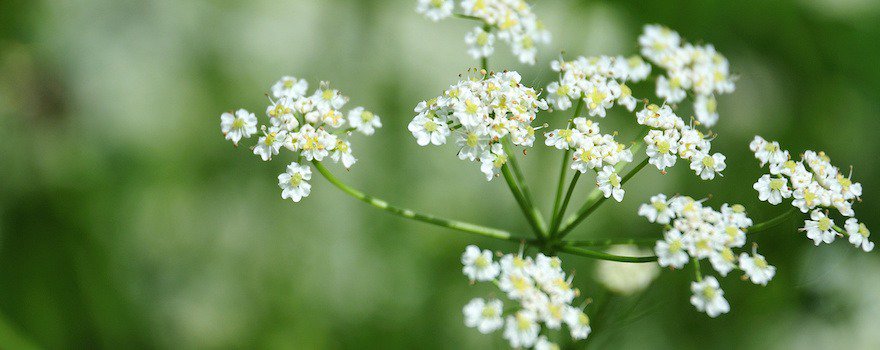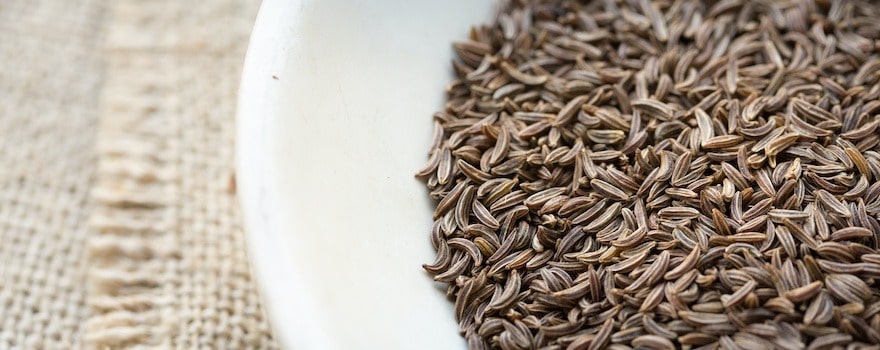BENEFITS OF CARAWAY
✓ Improves digestion
✓ Aids in weight loss
✓ Fights bacteria
✓ Improves diabetes
✓ Reduces cholesterol levels
What is caraway?
Caraway, scientifically named Carum carvi, is an herbaceous plant from the Apiaceae family, like dill, parsley, or celery. Also known as “meadow cumin” or “Vosges anise”, it has long been appreciated in cooking for its flavor qualities. Indeed, its aromatic seeds have a pleasant aniseed taste.
It grows in many temperate regions worldwide. It is found from Africa to Asia through Europe (France, Portugal, Germany…). The plant blooms from July to August. Its white flowers grouped in umbels are then replaced by dark brown aromatic seeds. Once harvested, they are used as a condiment but also consumed for their health benefits.
The use of caraway as a medicinal plant dates back to Antiquity. The seeds were used in many traditional medicines and notably in Persian medicine (Iran).
They contain valuable compounds including essential oils, proteins, fibers, vitamins, and minerals.
Today, its seeds are recognized for improving digestion and relieving gastrointestinal disorders. Their consumption also helps in weight loss, fighting bacteria, improving diabetes, and reducing cholesterol levels.
Caraway seeds are so aromatic that they are used to flavor certain traditional beverages. In Scandinavian countries, for example, they are combined with anise and fennel to make Aquavit brandy. They are also used to make Brennivín, an Icelandic alcoholic drink, and the famous Schnaps of the Germanic countries.
Nutritional composition
- Amino acids
- Vitamins: A, B1, B2, B3, B6, B9, C, E
- Minerals and trace elements: iron, calcium, potassium, magnesium, phosphorus, sodium, zinc, copper, manganese, selenium
- Proteins
- Fibers
- Lipids
- Carbohydrates
- Essential oils: limonene, pinene, carvone, carvone oxide
- Antioxidant agents: sterols

The benefits of caraway
♻️ Improves digestion
Caraway supports digestive functions and eases difficult digestion after meals. Simultaneously, it reduces associated discomforts such as bloating, flatulence, and spasms.
This action is due to the essential oils contained in the seeds. Also present in peppermint and dill, carvone is an active compound with carminative and spasmolytic effects: it absorbs intestinal gases and relieves abdominal pain.
It also contains limonene, which stimulates bile production and digestive enzymes. It also acts on gastric motility to optimize the digestive process.
This review from the TabibDaru pharmaceutical company of Kashan (Iran) focused on caraway’s action in relieving digestive disorders (dyspepsia).
🏃🏻♂️ Aids in weight loss
The consumption of caraway seeds can be beneficial for weight loss. Indeed, they have slimming properties and exert a natural appetite suppressant effect to limit snacking during the day.
They also increase the feeling of fullness and reduce body fat at the waist and thighs. Finally, by facilitating digestion, they help maintain a flat stomach.
This study from the University of Malaya (Malaysia), conducted on overweight patients, demonstrates the anti-obesity effect of caraway.
🦠 Fights bacteria
Like nigella seeds, caraway seeds are antibacterial and fight against certain pathogenic bacteria. They have shown particular effectiveness against Staphylococcus aureus and the bacterium Escherichia coli.
The seeds inhibit the growth and proliferation of these bacteria. Once again, it is the essential oils they contain (limonene and pinene) that are responsible for this action.
This study from Ferdowsi University of Mashhad (Iran), conducted directly in the laboratory, demonstrates the antibacterial activity of caraway.
🍭 Improves diabetes
Caraway seeds can be a valuable aid in type 2 diabetes. Indeed, they contain carveol, a liquid compound with antidiabetic potential.
In addition to lowering blood sugar levels, carveol reduces the level of glycated hemoglobin. This protein is responsible for capturing sugar in the blood. Its high level is an important marker of diabetes mellitus.
This study from Riphah International University (Pakistan), conducted on rats, shows the antidiabetic activity of caraway.
🍳 Reduces cholesterol levels
Caraway seeds have a hypolipidemic activity, meaning they normalize blood lipid levels (triglycerides and cholesterol).
On one hand, they reduce triglyceride levels. When present in excess, these fats are responsible for cardiovascular diseases. On the other hand, the seeds lower the “bad” cholesterol level (or LDL-cholesterol) and increase the “good” cholesterol (or HDL-cholesterol).
This study from Maharashtra University of Health Sciences (India), conducted on rats, shows the hypolipidemic action of caraway seeds.

How to consume caraway?
Caraway seeds
Often confused with cumin seeds, caraway seeds are also used as a spice but have a milder taste. They have a fresh, lemony, and aniseed flavor.
Once crushed, they help flavor many dishes, both savory and sweet: meats, vegetables, sauces, cheeses, citrus fruits, breads, and cakes… They pair very well with Middle Eastern recipes such as harira (traditional Moroccan soup) and harissa. These seeds are also interesting for flavoring herbal teas and infusions.

Sustainable consumption: favor local, fair-trade, and organic caraway
The Netherlands, Poland, and Hungary are the main producers of caraway. But it is also cultivated in Russia, Egypt, and India. In France, it adapts well to the climate of the Hexagon. It is a hardy plant, easy to grow and generally appreciated by herb producers.
If possible, favor caraway grown in France and organic farming. There are also fair-trade channels that support the work of small producers.
Dosage
It is recommended to consume up to 5 grams of caraway seeds per day.
Contraindications and side effects
Its consumption presents certain contraindications:
- As a precautionary measure, it is not recommended for pregnant women and young children;
- Individuals suffering from a liver disease should avoid consuming it.
Caraway consumption presents certain side effects:
- Headaches
- Allergic reactions
If you experience side effects, stop consumption and consult a doctor.
Dossier by Julia Perez
Sources and scientific studies
Mohaddese Mahboubi, 2018. Caraway as Important Medicinal Plants in Management of Diseases.
Mahnaz Kazemipoor, Sareena Hamzah, Majid Hajifaraji, Che Wan Jasimah Bt Wan Mohamed Radzi, Geoffrey A Cordell, 2016. Slimming and Appetite-Suppressing Effects of Caraway Aqueous Extract as a Natural Therapy in Physically Active Women.
Mohammad Mohsenzadeh, 2007. Evaluation of antibacterial activity of selected Iranian essential oils against Staphylococcus aureus and Escherichia coli in nutrient broth medium.
Muhammad Shabir Ahmed, Arif-Ullah Khan, Lina Tariq Al Kury, Fawad Ali Shah, 2020. Computational and Pharmacological Evaluation of Carveol for Antidiabetic Potential.



